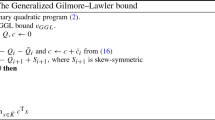Abstract
We consider transformations of the (metric) Quadratic Assignment Problem (QAP) that exploit the metric structure of a given instance. We show in particular how the structural properties of rectangular grids can be used to improve a given lower bound. Our work is motivated by previous research of Palubetskes (1988), and it extends a bounding approach proposed by Chakrapani and Skorin-Kapov (1993). Our computational results indicate that the present approach is practical; it has been applied to problems of dimension up ton = 150. Moreover, the new approach yields by far the best lower bounds on most of the instances of metric QAPs that we considered.
Similar content being viewed by others
References
R.E. Burkard, “Locations with spatial interactions: the quadratic assignment problem,” in: P.B. Mirchandani and R.L. Francis, eds.,Discrete Location Theory (Wiley, Berlin, 1991) pp. 387–437.
R.E. Burkard, S. Karisch and F. Rendl, “QAPLIB—a quadratic assignment problem library,”European Journal of Operational Research 55 (1) (1991) 115–119; updated version: 1994.
J. Chakrapani and J. Skorin-Kapov, “A constructive method to improve lower bounds for the quadratic assignment problem,” Working Paper (1993).
F.H. Clarke,Optimization and Nonsmooth Analysis (Wiley, New York, 1983).
W.E. Donath and A.J. Hoffman, “Lower bounds for the partitioning of graphs,”IBM Journal of Research and Development 17 (1973) 420–425.
P.C. Gilmore, “Optimal and suboptimal algorithms for the quadratic assignment problem,”SIAM Journal on Applied Mathematics 10 (1962) 305–313.
S.W. Hadley, F. Rendl and H. Wolkowicz, “A new lower bound via projection for the quadratic assignment problem,”Mathematics of Operations Research 17 (1992) 727–739.
L.H. Harper, “Optimal assignments of numbers to vertices,”Journal of the SIAM 12 (1964) 131–135.
C. Helmberg, B. Mohar, S. Poljak and F. Rendl, “A spectral approach to bandwidth and separator problems in graphs,”Linear and Multilinear Algebra 39 (1995) 73–90.
M. Juvan and B. Mohar, “Optimal linear labelings and eigenvalues of graphs,”Discrete Applied Mathematics 36 (2) (1992) 153–168.
P. Lancaster and M. Tismentesky,The Theory of Matrices: With Applications (Academic Press, New York, 2nd ed., 1985).
E. Lawler, “The quadratic assignment problem,”Management Science 9 (1963) 586–599.
T. Mautor, “Contribution à la résolution des problèmes d'implanation: algorithmes séquentiels et parallèles pour l'affectation quadratique,” Doctoral Thesis, Université Pierre et Marie Curie, Paris (1992).
G.S. Palubetskes, “Generation of quadratic assignment test problems with known optimal solutions,”Zhurnal Vychislitel'noi Matematiki i Matematicheskoi Fiziki 28 (11) (1988) 1740–1743 (in Russian).
P.M. Pardalos, F. Rendl and H. Wolkowicz, “The quadratic assignment problem: a survey of recent developments,” in: P. Pardalos and H. Wolkowicz, eds.,Quadratic Assignment and Related Problems, DIMACS Series in Discrete Mathematics and Theoretical Computer Science, Vol. 16 (American Mathematical Society, Providence, RI, 1994) pp. 1–42.
F. Rendl and H. Wolkowicz, “Applications of parametric programming and eigenvalue maximization to the quadratic assignment problem,”Mathematical Programming 53 (1) (1992) 63–78.
S. Sahni and T. Gonzales, “P-complete approximation problems,”Journal of the Association for Computing Machinery 23 (1976) 555–565.
H. Schramm and J. Zowe, “A combination of the bundle approach and the trust region concept,” in: J. Guddat et al., eds.,Advances in Mathematical Optimization (Akademie Verlag, Berlin, 1988) pp. 196–209.
H. Schramm and J. Zowe, “A version of the bundle idea for minimizing a nonsmooth function: conceptual idea, convergence analysis, numerical results,”SIAM Journal on Optimization 2 (1992) 121–152.
Author information
Authors and Affiliations
Additional information
The authors gratefully acknowledge financial support by the Christian Doppler Laboratorium für Diskrete Optimierung.
Rights and permissions
About this article
Cite this article
Karisch, S.E., Rendl, F. Lower bounds for the quadratic assignment problem via triangle decompositions. Mathematical Programming 71, 137–151 (1995). https://doi.org/10.1007/BF01585995
Received:
Revised:
Issue Date:
DOI: https://doi.org/10.1007/BF01585995




